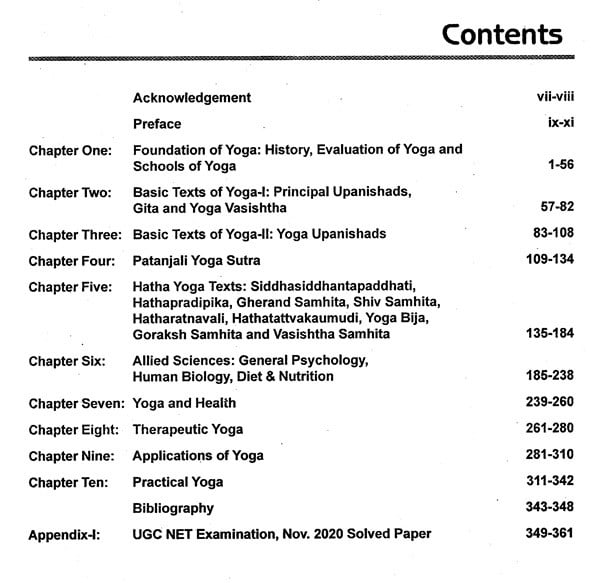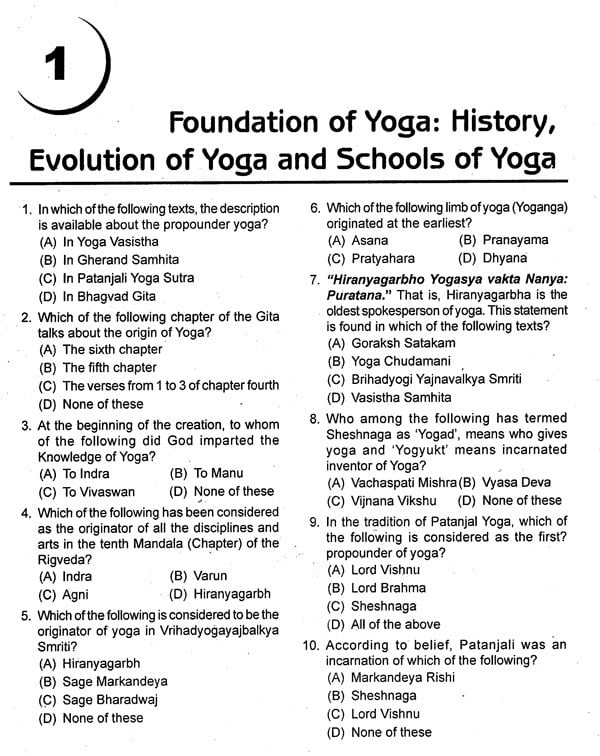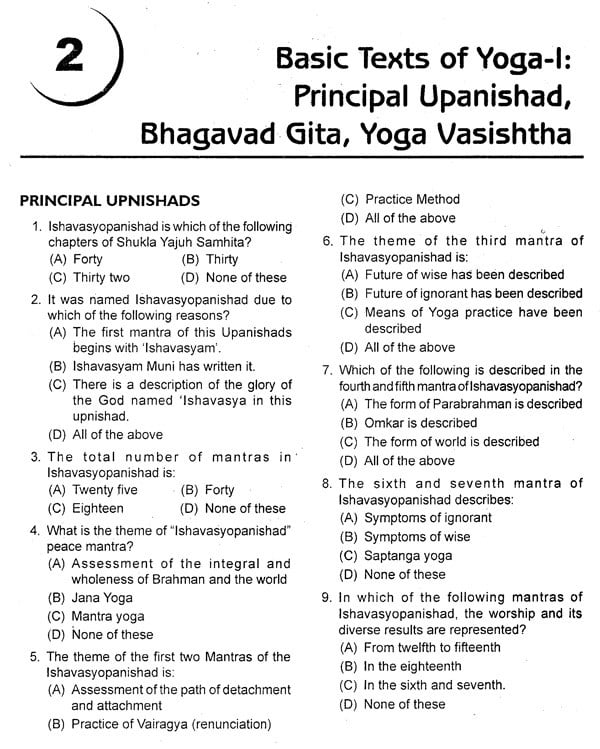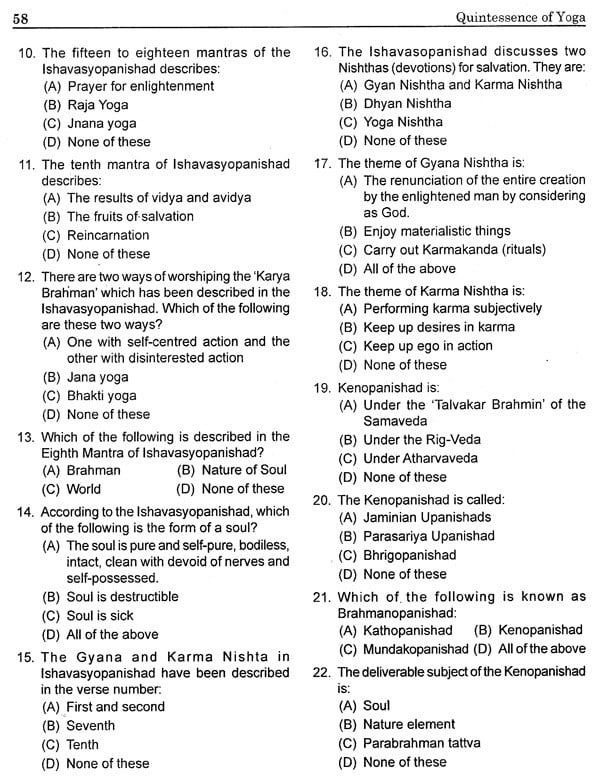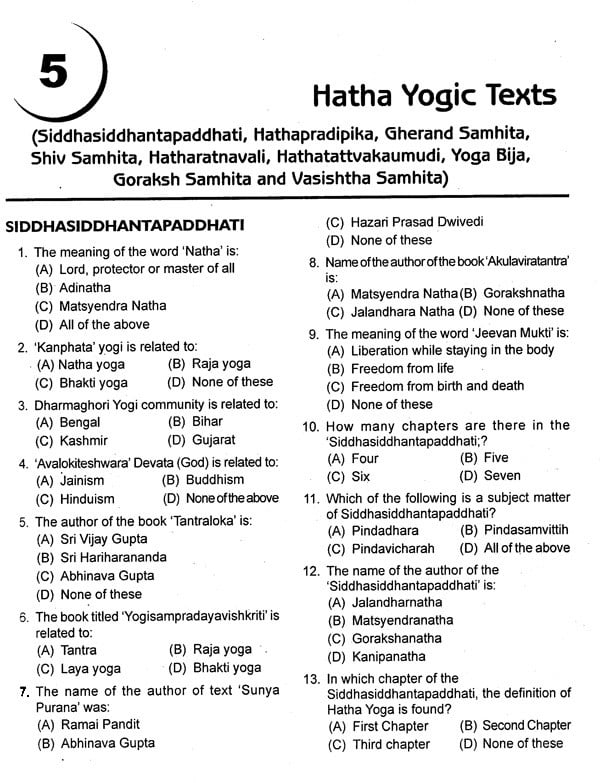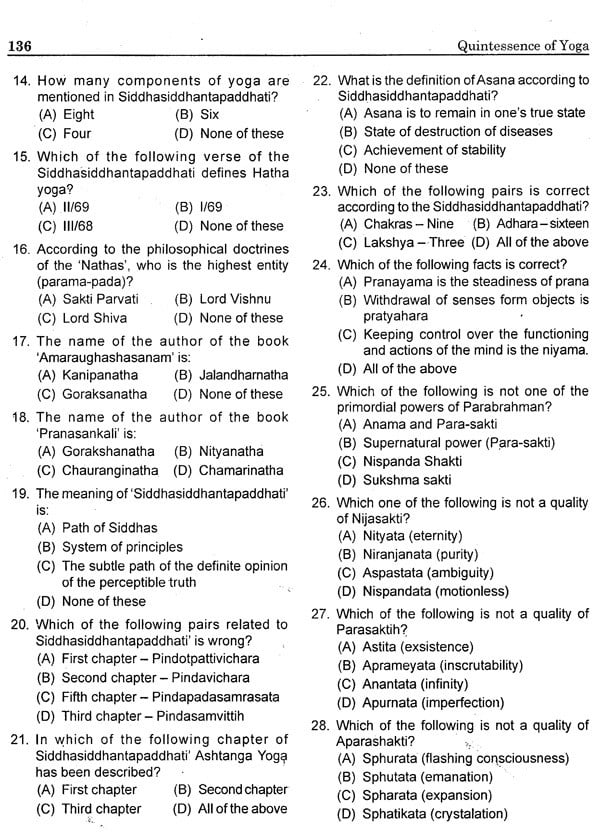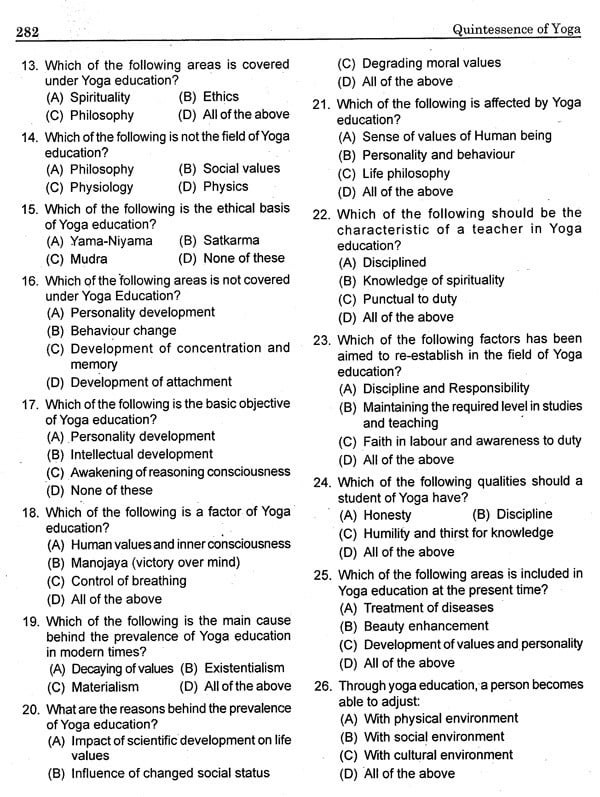
Quintessence of Yoga- A Complete Book For UGC NET and Other Entrance Examinations in Yoga
Book Specification
| Item Code: | AZB682 |
| Author: | Chintaharan Betal |
| Publisher: | Kitab Mahal |
| Language: | English |
| Edition: | 2021 |
| ISBN: | 9788195386789 |
| Pages: | 361 |
| Cover: | Paperback |
| Other Details | 9.5 x 7 Inches |
| Weight | 500 gm |
Book Description
The present book "Quintessence of Yoga" is a comprehensive coverage of the syllabus on Yoga prepared by the University Grants Commission (UGC) of India for conducting the National Eligibility Test (NET) for the appointment of teachers in colleges and universities. In this book, the entire prescribed syllabus has been dealt with objective type multiple choice questions (MCQ) and answers. The book has been designed in such a way that it will also be helpful for M.Phil., Ph.D. and other Entrance Examinations of Yoga Education. The whole book contains ten chapters and 4,200 Objective Types Multiple Choice Questions (MCQs) which are most informative, relevant and enlightening for qualifying the National Eligibility Test (NET) along with other examinations in the field of Yoga Education. Hope, that this book will surely meet the newly emerging demand of Objective Type Multiple Choice Questions (MCQs) for qualifying UGC NET and other entrance examinations of Yoga Education.
Dr. Chintaharan Betal has obtained his M.A. (1996) and Ph.D. (1999) degrees in Science of Living, Preksha Meditation and Yoga from Jain Vishva Bharati (Deemed) University, Ladnun, Rajasthan. He has also received the Post Graduate Diploma in Ecology and Environmental Science and the Certificates in Transcendental Meditation (TM.) and Acupressure. He has been continuously teaching the Post Graduate Students of Yogic Science since 28th April, 2004. Dr. Betal is sincerely working in the field of Applied Yoga and Meditation, guiding and supervising the Ph.D. Research Scholars. He has attended and delivered lectures in morethan 42 National and International Conferences and Seminars of Yoga and published more than 35 research papers in the Journals of National and International reputation. He has authored the books like (1) Preksha Meditation and Drug Abusers' Personality, (2) Hatha Yog Ki Bhumika, (3) Vastunishta Bahuvikalpiya Prasnottar Mei Yog. Currently, Dr. Betal is working as an Assistant Professor in the Department of Naturopathy and Yoga of Hemvati Nandan Bahuguna Garhwal Central University, Srinagar (Garhwal), Uttarakhand.
In the contemporary period, the consciousness of human values is becoming weak and speckled in the whole world. The dazzle of scientific and technological achievements, longing for materialistic pleasures, religious communalism and increasing influence of the modernization has alienated human being from ancient socio-cultural, ethical and spiritual values. This has amplified the criminal cases like homicide, suicide, rape, theft, drug trafficking and many other offensive and illegal acts in society which in turn have awfully polluted the entire social environment. A polluted society never considers the issues of violence, discriminations, injustice, sexual harassment and fairness sensitively and sympathetically. Hence, to cope with this challenging situation, the importance of inclusion of value-based subject and spiritual practice is being realized in the field of modern education and an attempt has been made to awaken the socio-cultural, ethical and spiritual consciousness among the students.
In this era of age-old challenges and cultural conflicts, where there is a continuous contradiction between material thirst and spiritual consciousness and where struggle is going on between policy and imperfection, prudence and indiscretion; the enforcement of value-based spiritual education like yoga education will certainly make the whole environment positive, constructive and ideal. Thus, the age-old vision of human being for establishing a healthy, peaceful, welfare and an ideal society will undoubtedly be realized. In this context, inclusion of 'Yoga' in higher education in India is a very meaningful, relevant and useful of the era.
A splendid amalgamation of spirituality, philosophy, lifestyle (ahara, vihara, achara and vichara), social and ethical values like yama-niyama along with the modern physiology, psychology, health science, pathology and therapy made this subject unique and incomparable, both in respect of offering a balanced psycho-physiological health, social and cultural enrichment and welfare of society. Such a synthetic science will also help not only in perfect intellectual development but also assure the development of scientific cum spiritual personality within the students.
The book titled "Quintessence of Yoga" is a comprehensive coverage of the syllabus on Yoga introduced by the University Grants Commission (UGC) for conducting the National Eligibility Test (NET) for the appointment of teachers in colleges and universities. In this book, the entire prescribed syllabus has been dealt with objective type multiple choice questions (MCQ) and answers.
The first chapter 'Foundation of Yoga: History, Evaluation of Yoga and Schools of Yoga' deals with the origin, historical development, meaning and definitions, misconceptions, aim and objectives of Yoga. The significant contributions by various Maharishis to the development of Yoga in contemporary times along with the differences of yoga philosophy and yoga practice in various Vedic and non-Vedic philosophies have been incorporated in this chapter. The exhaustive multiple choice questions on introduction to Jnanayoga, Bhaktiyoga, Karmayoga, Rajayoga, Hathayoga anc Mantra Yoga along with the elements of Yoga in Jainism and Buddhism have been prepared to strengthen the qualitative aspects of the book .
The second chapter of the book namely 'Basic Texts of Yoga: Major Upanishads, Bhagavad Gita, Yoga Vashishtha' includes several hundreds of objective type multiple choice questions which are related to ten ancient Upanishads as well as the prescribed curriculum of Bhagavad Gita and Yoga Vashistha.
The third chapter named as 'Basic Texts of Yoga-II:Yoga Upnishads' includes the most relevant objective type multiple choice questions on Shvetashvataropanishad, Yogakundalyupanishad, Yoga Chudamanyupanishad, Trishikhibrahmanopanishad, Yoga tattvopanishad, Dhyanabindupanishad, Nadabindupanishad, Yogarajopanishad as upanishads are considered as the foundation of ancient Yogic literature.
The fourth chapter which is termed as 'Patanjal Yogasutra', deals with the meaning & symptoms of yoga; concept of Chitta, Chitta-Bhumis, Chitta-Vrittis, Chitta-Vrittinirodhopaya, Abhyasa and Vairagya etc. The concept of Kriya Yoga, theory of Kleshas ; concept of Karmashaya and Karmvipaka, nature of dhukha, concept of Chaturvyuhavada have been discussed with suitable multiple choice questions and answers. Introduction of Dharana, Dhyana and Samadhi, nature of Sanyama; concept of Chitta samskara, Parinamatraya and vibhutis are also incorporated in this chapter. Five means of Siddhis, ,concept of Nirman Chitta, importance of Siddhis achieved through Samadhi, four types of Karmas; concept of Vasana; Dharmamegh Samadhi and its result, Viveka Khyati Nirupanam, Kaivalya Nirvachan and many other topics of Patanjal Yoga Sutra are well discussed with large number of objective-based multiple-choice questions and answers.
In the fifth chapter of the book 'Hatha Yoga Texts', the famous treatise of Natha Sampradaya like Siddhasiddhantapaddhati as well as the applied texts of Hatha Yoga, such as Hathapradipika, Gherand Samhita, Hatharatnavali, Shiva Samhita, Hathatattvakaumudi, Yoga Beeja, Goraksha Samhita, Vashishtha Samhita are included. Besides, Asana, Pranayama, Meditation and many other important topics like Kundalini Jagaran, Nadanusandhana and Hatha Samadhi are also incorporated with suitable objective type multiple choice questions and answers.
The sixth.chapter of the book titled 'Allied Sciences: General Psychology, Human Biology, Diet & Nutrition,' is adorned with the topics like altered states of consciousness, behavioural psychology, personality, cognitive psychology and mental health. In addition to these, many topics under anatomy and physiology, diet and nutrition, classification of diet and their specialty, rules of diet, various vitamins, minerals and their sources etc. are also described with appropriate multiple choice questions and answers.
In the seventh chapter of the book, namely 'Yoga and Health' a large number of objective type multiple-choice questions have been formulated keeping in view the important topics like definition and importance of health according to WHO; dimengions of health: physical, mental, social and spiritual, concepts of trigunas, pancha-mahabhutas, pancha-prana' and their role in health and healing. The topics like yogic principles of healthy living, i.e., ahara, vihara, achara and vichara; role of yogic positive attitudes are well described through multiple choice questions and answers.
The eighth chapter of the book entitled as 'Therapeutic Yoga', discusses with the topics like management of the diseases through suitable yogic practices such as yogic diet, yama and niyama, shatkarma, asana, pranayama, meditation and changes in lifestyle according to yogic scriptures. The topics like integrated approach of yoga therapy for common ailments such as obstetrics and gynaecological disorders, menstrual disorders: Gastrointestinal disorders like gastritis, indigestion, peptic ulcers, constipation, diarrhoea, irritable bowel syndrome, colitis, piles and neurological disorders, migraine, tension-headache, epilepsy and psychiatric disorders like neurosis, anxiety disorders, phobias, depression are well designed with huge number of MCQs. The chapter has been completed with a large number of objective type multiple choice questions, having a deep insight and analytical perspective on important topics such as the use of yoga in the field of education, the use of yoga in stress management, the use of yoga in personality development etc.
In the ninth chapter "Applications of Yoga", multiple choice questions are designed on applied philosophy, yoga as applied philosophy; meaning, definition and nature of consciousness as described in Vedas„ Upanishads, Bhagwad Gita, Yogasutra and Yogavasishtha and spiritual and scientific approach to human consciousness. Multiple choice questions have also been prepared on the topics like yoga in education, salient features of yoga education, factors of yoga education; teacher, student and teaching. The area such as value based education, meaning, definition; types of values are also covered by many questions. The topics like teaching and learning, concepts and relationship between the two; principles of teaching, meaning and scope of teaching methods and factors influencing them; teaching techniques— Individual, group and mass, are well described through multiple choice questions and answers. In this chapter, benefits of various topics of yoga, teaching-training, lesson plan, characteristic of yoga class, student's behaviour towards yoga teacher and specialty of yoga teacher have been incorporated in this chapter.
In the last, i.e., in the tenth chapter of the book,namely 'Practical Yoga', areas like Shatkarma, Asana, Pranayama, Mudra, Bandha, Dhyana, Surya namaskara are equipped with many objective type multiple choice questions. Vamandhauti, Vastradhauti, Dandadhauti, Laghoo and Poorna sankhaprakshalana, Neti (Sutra and Jala), Kapalbhati (Vaatkrama,Vyutakrama & Sheetkarma), Agnisara,.Nauli, Trataka have been described. Yogic postures like standing postures, sitting postures, prone postures, supine postures, balancing postures are described with many MCQs. This chapter also includes the topics like breath awareness, sectional breathing and pranayama like Nadishuddhi, Suryabhedan, Ujjai, Sitali, Sitkari, Bhastrika, Bhramari, Bahyavritti, Abhyantarvritti, Stambhavritti. It incorporates meditation, Pranava and Soham Japa, Yoga Nidra, Antarmauna, Ajapa Japa as psycho-meditative exercises. The various types of meditation like breath meditation, Om meditation, Vipassana meditation, Preksha Meditation along with Bandhas and Mudras and contemporary yogic practices are also included in this chapter. All the topic are described with suitable objective type multiple choice questions and answers.
**Contents and Sample Pages**
